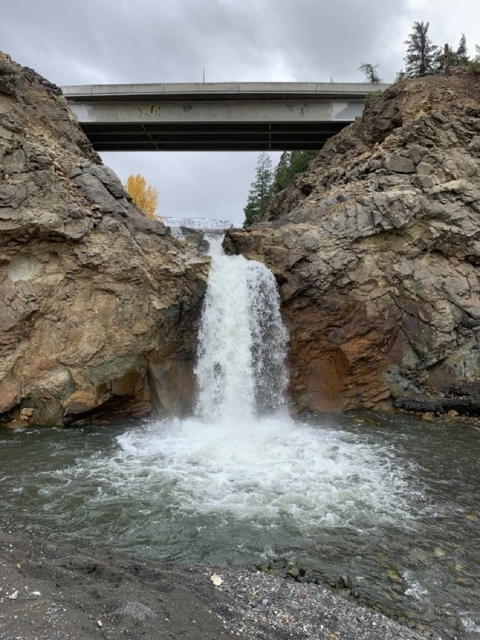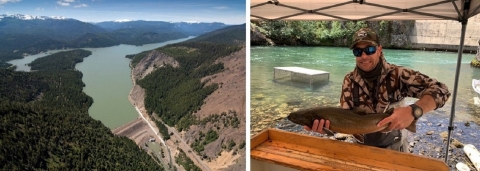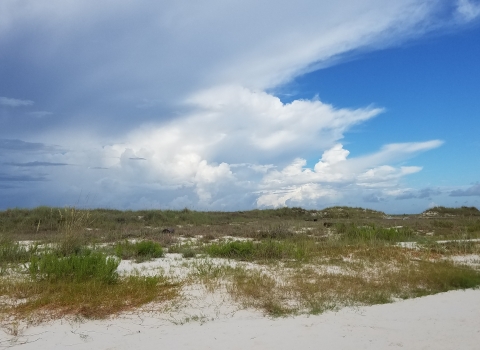By Jan Peterson, for the U.S. Fish and Wildlife Service’s Pacific Region
Sometimes in solving a problem, you create a bigger one.
Such was the case in 1985, when a wood log trestle bridge spanning the South Fork Tieton River in Yakima County, Washington, was failing. The county and federal government agreed the bridge – built in the early 1930s in conjunction with the construction of Tieton Dam – needed to be replaced.
Trouble was, the new bridge couldn’t be set across the river’s natural flow. The river was aligned between a spur of weak volcanic rock on the west and a slow-moving glacial-clay landslide to the east. So they filled the natural channel, cut a deep notch through the rock as a new river channel, realigned the road and put in a safe new bridge. But in so doing, they created a nightmare for bull trout and other fish who used the passage. Because the river channel changed, a 40-foot waterfall appears just downstream each September when the Rimrock Reservoir is drawn down.
The waterfall puts out-migrating post-spawn bull trout at great peril and blocks spawning access for kokanee and other salmonids. This is of tremendous concern because the South Fork Tieton River supports the largest bull trout population in the Yakima Basin.
“They’re tough critters, but it’s a valid concern when (bull trout) are exiting the system. When those falls are there, they could be stunned and otters pick them off. It’s not a good situation,” says Jason Romine, deputy project leader at the U.S. Fish and Wildlife Service’s Mid-Columbia Fish and Wildlife Conservation Office.
Richard Visser, with the Bureau of Reclamation, is less subtle about the waterfall’s impact: “If they don’t get out of the stream soon enough, they’re going to go over the waterfall. We’ve had reports of bull trout below the waterfall dead.”
The Bipartisan Infrastructure Law Bipartisan Infrastructure Law
The Bipartisan Infrastructure Law (BIL) is a once-in-a-generation investment in the nation’s infrastructure and economic competitiveness. We were directly appropriated $455 million over five years in BIL funds for programs related to the President’s America the Beautiful initiative.
Learn more about Bipartisan Infrastructure Law is helping to fund a project that will address this fish passage fish passage
Fish passage is the ability of fish or other aquatic species to move freely throughout their life to find food, reproduce, and complete their natural migration cycles. Millions of barriers to fish passage across the country are fragmenting habitat and leading to species declines. The U.S. Fish and Wildlife Service's National Fish Passage Program is working to reconnect watersheds to benefit both wildlife and people.
Learn more about fish passage problem. The project calls for putting in a new bridge at the original river channel alignment.
This new bridge and its location is expected to have three major benefits in addition to eliminating the potentially lethal waterfall:
- It will provide a very large area of new spawning habitat for fish that currently inhabit the reservoir.
- It will prepare the reservoir for planned reintroduction of sockeye salmon and Endangered Species Act-listed (threatened) steelhead.
- It will provide additional flexibility for Reclamation as it manages Rimrock Reservoir for benefits in the Tieton River downstream of Tieton Dam.
Yakima County is the lead on this project. In addition to the Service, key partners include the U.S. Forest Service, Reclamation, the Confederated Tribes and Bands of the Yakama Nation, Washington Department of Fish and Wildlife and the Washington Department of Ecology. The Bipartisan Infrastructure Law is providing $400,000 in funding, Reclamation is providing $700,000 and Ecology is providing $1.4 million through the Yakima Basin Integrated Plan.
Joel Freudenthal, water resources strategic manager for Yakima County, says while the bridge will make an important difference for fish passage on the South Fork Tieton River, it will have an impact on the entire Yakima Basin.
Of the five major reservoirs in the Yakima River Basin, Rimrock Reservoir is the system’s second largest. “We have a gentleman’s agreement between Reclamation and the FWS to hold the reservoir high until August, which isn’t really what I would term the complete migration window for trout,” Freudenthal says.
“On an annual basis, if you didn’t have that constraint, you could manage the basin somewhat differently and release water out of that reservoir,” he says. “It’s very cold water, so you could cool the water a long way downstream. Sockeye trying to come up the river in summer are struggling. It could help with sockeye reintroduction by cooling the river.”
Freudenthal credits the Yakima Basin Integrated Plan for making the project possible. The 30-year plan is a national model for collaborative water resource planning for the agricultural region that generates approximately $1 billion in annual revenue.
“Normally, this would be a very, very complicated thing, but because people are willing to cooperate, it may make it a little simpler,” he says.
The new 130-foot bridge and stream redirection is in the planning phases. Hopes are to break ground on the project in September 2023 and complete construction by April 2024.
“The problem is because of the setting, you can’t start it any old month. We need to start the project when the reservoir is down, which is September,” says Visser. “If you miss your work window in ’23, you’re going to have to start in 2024.”
The South Fork Tieton Bridge project is just one of many projects being funded with help from the Bipartsan Infrastructure Law. The once-in-a-lifetime investment is helping local, state and Tribal communities tackle the climate crisis while creating jobs, and boosting local economies. By funding efforts to address intensifying drought, wildfires, flooding and legacy pollution, the law is the largest investment in the resilience of physical and natural systems in American history. Together we will build back better ecosystems and protect wildlife and wild spaces for the next generation.





